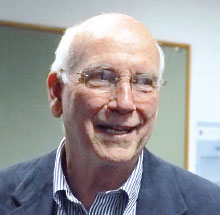Neuroscience Reveals How Psychotherapies May Undo Maladaptive Patterns
Abstract
Maladaptive behavior patterns were invented by the mind as a way to solve an early problem, and those patterns become encoded in neural pathways.

Psychotherapy was originally conceived by “geniuses who had their own ideas but were shooting in the dark.”—Jeffrey Smith, M.D.
Whatever types of psychotherapy you practice—psychoanalytic, psychodynamic, cognitive-behavioral, dialectical, transference-based—there are common features that cause them to work. Moreover, there appear to be several distinct neural pathways through which different psychotherapies work, according to Jeffrey Smith, M.D., the new head of the APA Caucus on Psychotherapy.
That’s based on a new neuroscientific understanding of the “architecture of the mind,” the way self-destructive behaviors and reactions become encoded in neural networks. Psychotherapy can be used to change those behaviors, he said.
“Psychotherapists desire a stronger place in medicine for psychotherapy, but historically there has tended to be infighting among adherents to this or that therapy,” he said.
He likens the infighting to competition among schools of philosophy dating to the time of the Greeks, whose disagreements, based on conjecture, took on a quasi-religious nature. Similarly, he said, psychotherapy was originally conceived by “geniuses who had their own ideas but were shooting in the dark” when it came to knowing precisely how their therapies worked.
That’s changing. “Recently well-established science from diverse sources has begun to make possible an understanding of the neurobiology of the mind such that we might soon agree on a common infrastructure for all of the psychotherapies,” Smith said.
He told Psychiatric News that one goal of his tenure as caucus leader is to better publicize the insights of translational neurobiology that support the action of psychotherapy. For more than a decade, Smith has explored these issues in a blog titled “How Therapy Works: Moments of Change in Life and Therapy”.
Early in his career as a psychotherapist, Smith said he was confronted with aspects of his patients’ lives—especially, early life trauma and addiction—that caused him to want to know more about how maladaptive behavior patterns are encoded in the mind and how psychotherapy works to undo those patterns.
“Maladaptive behavior patterns were invented by the mind at some point in our lives to solve a problem, and those patterns become encoded in neural networks,” he said.
All the forms of psychotherapy, he said, undo those patterns through one or more of three final pathways:
New learning: Patients learn new patterns of coping that are healthy and satisfactory. Sometimes adoption and practicing of new ideas or behaviors are sufficient for maladaptive patterns to be relinquished.
Cortical inhibition: In the mechanisms commonly known as extinction, new learning in the cortex triggers inhibitory signals sent to the limbic areas where maladaptive patterns originate. In this way, a learned dysfunctional response can be suppressed. Extinction is thought to be the mechanism of exposure therapy, but the benefit may not be permanent.
Memory reconsolidation: When established pathways such as learned fear are activated, they are simultaneously contradicted in the course of therapy, synapses can be reprogrammed with the new information in a way that is enduring and does not require effort to maintain.
Smith said that beyond those three change mechanisms, there are four facilitating factors critical to the success of any psychotherapy:
Relationship: Much research underscores the critical importance of the relationship between therapist and patient.
Motivation: Most therapies have ways to support motivation to do the work of psychotherapy, which can be emotionally difficult and sometimes lengthy.
Safety: Patients need the feeling they have a protected environment to do the work of therapy.
Arousal regulation: If patients are too upset to learn or too disconnected to recognize and name their emotions, there is no window for the therapy to work. Patients need to experience a reflective calm in the course of therapy.
Smith said he believes an understanding of the common infrastructure of therapy could help to unite the field. And a neuroscientific understanding of the architecture and functioning of the mind might increase insurers’ support of psychotherapy.
“We have gotten to the point of understanding specific neurobiological principles of individual maladaptive responses, how behavioral problems are encoded in neural networks, and how people change in psychotherapy,” Smith said. “I believe the timing is right, and the ground is fertile.” ■



